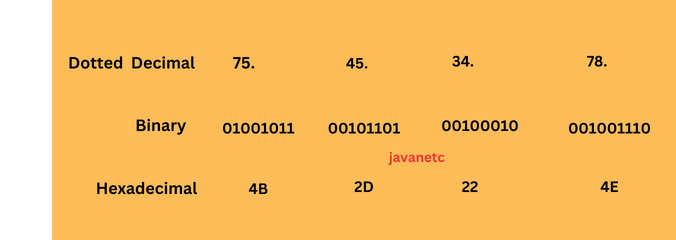Introduction
The IPv4 Address, or Internet Protocol version 4, is indeed the fourth iteration of the Internet Protocol. It uses 32-bit addresses, typically expressed as four octets separated by dots (e.g., 192.168.1.1), to uniquely identify devices on a network. These addresses are crucial for devices to communicate with each other over the internet. IPv6, on the other hand, is the newer version of the protocol, designed to address the limitations of IPv4, particularly its finite address space, by using 128-bit addresses. Both IPv4 and IPv6 are still in use today, with IPv6 gradually being adopted to accommodate the growing number of internet-connected devices.
Table of Contents
What is the IPv4 Address?
Consider the analogy of a telephone. Making a call requires knowing the other person’s phone number; without it, communication is impossible. Similarly, sending data to a host on the internet requires the recipient’s address. This address uniquely identifies the host, enabling data transfer and communication.
There are forms of IP addresses:IPv4 and IPv6. IPv4, the fourth version of the Internet Protocol, has a 32-bit address, while IPv6 has a 128-bit address. The ‘v’ in IPv4 and IPv6 signifies “version.”
IPv4 addresses are divided into two parts: the network part and the host part (netid and hostid), a concept we’ll delve into later.
These addresses are 32-bit, organized into 4 octets (1 octet = 8 bits). Typically, they are represented in dotted decimals, but binary representation is an alternative.
Example:
192.168.1.152

Let’s take a look at the different notations for IPv4 addresses.

Why Do We Use IPv4 Addressing?
As previously discussed, unique addresses are essential to identify both the sender and the receiver, enabling data transmission once a connection is established. To access services on the internet, our devices require unique addresses, known as IP addresses.
IPv4 addresses operate at the network layer, facilitating data transmission through packets. It’s worth noting that IPv4 operates as a connectionless protocol, meaning it doesn’t establish a dedicated connection before transmitting data. Instead, it sends packets independently, each containing the necessary routing information to reach its destination.
IPv4 utilizes a 32-bit address space, providing approximately 4.29 billion unique addresses. However, significant blocks are reserved for specific networking purposes, such as private IP address ranges for local networks, multicast addresses, and addresses reserved for special uses like loopback and broadcast.
Different Types of Addressing Modes
Addressing modes in IPv4 refer to the methods used to target hosts on a network. There are three primary addressing modes:
Unicast Addressing Mode:
Unicast addressing involves sending data to a single host. In this mode, there is a one-to-one relationship between the source and destination. The destination address field contains the 32-bit IP address of the specific host. Unicast addressing is the most common mode used in networking.
Broadcast Addressing Mode:
Broadcast addressing mode involves sending data to all devices within a network, reaching multiple hosts simultaneously. The destination address field in the packet contains the special broadcast address, represented by 255.255.255.255. When a client sends a packet using this address, it is received by all other devices on the network.
Multicast Addressing Mode:
Multicast addressing mode involves sending data from one source to a group of designated recipients. Unlike unicast and broadcast, this mode establishes a one-to-many relationship between the source and multiple destinations. The destination address field contains a special address starting with 224.x.x.x, indicating a multicast group.
Each addressing mode serves different communication needs, allowing for targeted, widespread, or group-based data transmission within IPv4 networks.
Parts of IPv4
As introduced earlier, the IPv4 address comprises two essential components: the network part, also referred to as the net id, and the host part, known as the host id.
Before delving into their details, it’s essential to understand the classes of IPv4 addresses, which are Class A, Class B, Class C, Class D, and Class E. These classes are categorized based on address space, dividing it into fixed blocks with predetermined numbers of hosts.

Parts of IPv4 Address
Each class has a distinct allocation of hostid and netid. Now, let’s explore the meanings of the network part and host part.
Network Part (Net ID):
The network part, or net id, serves to categorize the network to which the host is connected. It helps in routing and organizing devices within a specific network class.
Host Part (Host ID):
The host part, or host id, is the segment of the IP address used to uniquely identify a particular host on a network. It distinguishes individual devices within the identified network, allowing for precise communication and data transfer.
Characteristics of IPv4 Address
- IPv4 addresses are 32 bits in length and can be represented in binary, dotted-decimal, or hexadecimal notation, with dotted decimal being the most common format.
- The classful addressing of IPv4 divides the address space into five classes: Class A, Class B, Class C, Class D, and Class E.
- Each IPv4 address is unique, ensuring that two devices on a network cannot share the same IP address.
- An IPv4 address comprises two parts: the network part and the host part, contributing to the hierarchical organization of networks.
- The IPv4 packet header contains 20 bytes of data, and the 12th field in the header is notable.
- IPv4 operates as a connectionless protocol, transmitting data without establishing a dedicated connection beforehand.
- IPv4 supports three addressing modes: unicast, broadcast, and multicast, catering to different communication needs.
- IPv4 addresses can be assigned manually or through DHCP (Dynamic Host Configuration Protocol), a protocol facilitating automatic IP address configuration.
- While transmitting packets, IPv4 may be considered unreliable due to factors like packet loss and lack of error-checking mechanisms.
Advantages of IPv4 Addressing
- IPv4 operates as a connectionless protocol, meaning it does not establish a dedicated connection before transmitting data.
- IPv4 routing can be efficiently managed by all systems, facilitating connectivity across large networks without the need for Network Address Translation (NAT).
- The routing process in IPv4 is streamlined, benefiting from effective address aggregation techniques.
- Privacy and security measures in IPv4 primarily rely on external mechanisms rather than encryption within the packets themselves.
- While IPv4 encoding is generally reliable, occasional flaws may still occur.
Disadvantages of IPv4 Addressing
- IPv4 addresses can be assigned manually or through the Dynamic Host Configuration Protocol (DHCP), although DHCP configuration requires substantial infrastructure management.
- Due to its early establishment, IPv4 lacks inherent security measures against modern threats. Internet Protocol Security (IPSec) addresses this by offering network security specifications for IPv4. However, its adoption faces challenges, as its implementation is not universally mandatory.
- A significant portion of IP addresses are reserved within the United States.
- IPv6 was introduced to address the limitations of IPv4 and overcome its drawbacks.
Conclusion
- IPv4, the fourth iteration of the Internet Protocol, employs 32-bit addresses, uniquely identifying each host or device on the internet.
- IP addresses enable connectivity between hosts, facilitating communication across the internet.
- An IPv4 address comprises two parts: the network part (netid) and the host part (hostid), delineating network hierarchy.
- IPv4 supports three addressing modes: Unicast, Broadcast, and Multicast, tailored to diverse communication needs.
- Operating at the Network Layer, IPv4 facilitates packet-based data transmission as a connectionless protocol.
- IPv4 addresses can be assigned manually or through DHCP (Dynamic Host Configuration Protocol), automating the configuration process.
- IPv6 was introduced to address IPv4’s limitations, offering enhancements to accommodate the evolving demands of internet connectivity.



